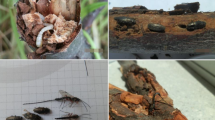Abstract
Infection rates of pinhole disease in farmed Undaria pinnatifida (Harvey) Suringar were examined between November 2002 and April 2003 at an Undaria farm at Wando on the southwestern coast of Korea. The growth stages of U. pinnatifida can be defined as: a growth phase from December to the end of February, and a decay phase from March to April. There was a significant increase in the level of infection with pinhole disease (measured as the number of pinholes per cm2) between December and April (P < 0.01). Infection progressed from the upper part of the frond in December to the basal part in April. The infection rate of pinhole disease in relation to growth phase on farms over time is limited by the harvest of the seaweed crop at the end of the cultivation period in April. The midrib, sporophyll and stipe showed no signs of infection at any time during the cultivation period. The reduced physiological activity and tissue aging that occurred over time in the sporophytic life phase is the probable cause of the increasing infection rate of the disease.





Similar content being viewed by others
References
Andrews JH (1976) The pathology of marine algae. Bio Review 51:211–253
Andrews JH (1979) Pathology of seaweeds: current status and future prospects. Experientia 35:429–450
Correa JA, Craigie JS (1991) Algal pathology. In: Reina GG, Pedersen M (eds) Seaweed cellular biotechnology, physiology and intensive cultivation. Proceedings COST-48 (Subgroup 1) Workshop. Universidad De Las Palmas De Gran Canaria, pp 67–82
Ho JS, Hong JS (1988) Harpacticoid copepods (Thalestridae) infesting the cultivated Wakame (brown alga, Undaria pinnatifida) in Korea. J Nat His 22:1623–1637
Kang JW (1981) Some seaweed disease occurred at seaweed farms along the south-eastern coast of Korea. Bull Korean Fish Soc 14:165–170
Kumura T, Yasui H, Mizuta H (2006) Nutrient requirement for zoospore formation in two alariaceous plants Undaria pinnatifida (Harvey) Suringar and Alaria crassifolia Kjellman (Phaeophyceae: Laminariales). Fish Sci 72:860–869
Kurogi M, Akiyama K (1957) Studies of ecology and culture of Undaria pinnatifida (Sur.) Hariot. Bull Tohoju Reg Fish Res Lab 10:95–117
MOMAF (2007) Statistical year book of Ministry of Maritime Affairs and Fisheries. Ministry of Maritime Affairs and Fisheries, Korea. http://badarosi.momaf.go.kr. Cited 3 January 2007
Morita T, Jurashima A, Maegawa M (2003) Temperature requirements for the growth of young sporophytes of Undaria pinnatifida and Undaria undarioides (Laminariales, Phaeophyceae). Phycol Res 51:266–270
Nishikawa H (1967) Studies on the cultivation of Undaria pinnatifida: IV. Focused on growth and erosion (a prediction). Aquaculture 14:197–203
Park TS, Rho YG, Gong YG, Lee DY (1990) A harpacticoid copepod parasitic in the cultivated brown alga Undaria pinnatifida in Korea. Bull Korean Fish Soc 23:439–442
Rho YG, Gong YG, Lee DY, Cho YC, Jang JW (1993) On the parasitic copepod (Harpacticoida) in the cultivated brown alga, Undaria pinnatifida (Harvey) Suringar. Bull Nat Fish Res Dev Agency 47:197–210
Torii S, Yamamoto H (1975) Thalestris sp. a parasitic Copepoda on Undaria pinnatifida (a preliminary report). Hokusuishi Geppo 32:23–34
Tseng CK (1981) Commercial cultivation. In: Lobban CS, Wynne MJ (eds) The biology of seaweeds. University of California Press, Berkley, pp 680–725
Yoshikawa T, Takeuchi I, Furuya K (2001) Active erosion of Undaria pinnatifida Suringar (Laminariales, Phaeophyceae) mass-cultured in Otsuchi Bay in northeastern Japan. J Exp Mar Biol Ecol 266:51–65
Acknowledgments
This research was supported by a grant (E10600107A060000140) from the “Greenhouse gas removal by seaweed” Program funded by the Ministry of Maritime Affairs and Fisheries of Korean government and the National Fisheries Research and Development Institute (RP-2008-AQ-009). We thank Dr. Philip Heath (NIWA, New Zealand) for reviewing the English.
Author information
Authors and Affiliations
Corresponding author
Rights and permissions
About this article
Cite this article
Park, C.S., Park, K.Y., Baek, J.M. et al. The occurrence of pinhole disease in relation to developmental stage in cultivated Undaria pinnatifida (Harvey) Suringar (Phaeophyta) in Korea. J Appl Phycol 20, 485–490 (2008). https://doi.org/10.1007/s10811-008-9329-1
Received:
Revised:
Accepted:
Published:
Issue Date:
DOI: https://doi.org/10.1007/s10811-008-9329-1




